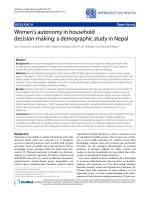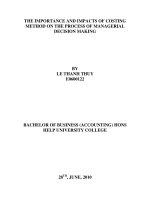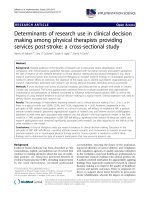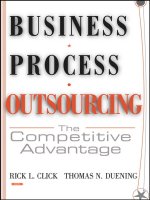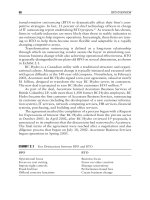Lecture Judgment in managerial decision making (8e) - Chapter 5: Framing and the reversal of preferences
Bạn đang xem bản rút gọn của tài liệu. Xem và tải ngay bản đầy đủ của tài liệu tại đây (185.55 KB, 26 trang )
Judgment in Managerial Decision
Making 8e
Chapter 5
Framing and the Reversal of
Preferences
Copyright 2013 John Wiley &
Sons
The Asian Disease Problem
Imagine that the United States is preparing
for the outbreak of an unusual Asian disease
that is expected to kill 600 people. Two
alternative programs to combat the disease
have been proposed. Assume that the exact
scientific estimates of the consequences of
the programs are as follows.
Program A: If Program A is adopted, 200
people will be saved.
Big Positive Gamble
You can (a) receive $10 million for sure
(expected value = $10 million) or (b) flip a
coin and receive $22 million for heads but
nothing for tails (expected value = $11
million). An expected-value decision rule
would require you to pick (b).
What would you do?
Lawsuit
You are being sued for $500,000 and
estimate that you have a 50 percent chance
of losing the case in court (expected value =
–$250,000). However, the other side is
willing to accept an out-of-court settlement
of $240,000 (expected value = –$240,000).
An expected-value decision rule would lead
you to settle out of court.
Ignoring attorney’s fees, court costs,
aggravation, and so on, would you (a) fight
Asian Disease Problem
Imagine that the United States is preparing
for the outbreak of an unusual Asian disease
that is expected to kill 600 people. Two
alternative programs to combat the disease
have been proposed. Assume that the
scien-tific estimates of the consequences of
the programs are as follows.
Program C: If Program C is adopted, 400
people will die.
Sell or Hold?
You were given 100 shares of stock in XYZ
Corporation two years ago, when the value
of the stock was $20 per share.
Unfortunately, the stock has dropped to $10
per share during the two years that you
have held the asset. The corporation is
currently drilling for oil in an area that may
turn out to be a big “hit.” On the other hand,
they may find nothing. Geological analysis
suggests that if they hit, the stock is
Preference Reversals
•
Sub-optimal decision portfolios
•
“Pseudocertainty” and our judgments
•
Insurance
•
Evaluations of transactions
•
Ownership and framing
•
Mental accounting
•
Bonuses versus rebates
•
Separate versus joint evaluation
Framing and the Irrationality of
the Sum of Our Choices
Imagine that you face the following pair of
concurrent decisions. First, examine both
decisions, and then indicate the options you
prefer.
Decision A
Choose between:
a. a sure gain of $240
b. a 25 percent chance to gain $1,000 and a
What Do People Choose?
•
Decision A
•
Decision B
Framing and the Irrationality of
the Sum of Our Choices
Choose between:
e. a 25 percent chance to win $240 and a 75
percent chance to lose $760
f. a 25 percent chance to win $250 and a 75
percent chance to lose $750
Russian Roulette
Question 1
How much would you pay to remove the
bullet and reduce the likelihood of death
from 1/6 (17%) to 0?
Question 2
In a game with two bullets, how much would
you pay to remove one bullet and reduce
the likelihood of death from 1/3 (33%) to 1/6
Perceptions of Certainty
Which of the following
options do you prefer?
a. a sure win of $30
b. an 80 percent
chance to win $45
Consider the following
two-stage game. In the
first stage, there is a 75
percent chance to end
the game without
winning anything and a
25 percent chance to
move into the second
stage. If you reach the
second stage you have
a choice between:
c. a sure win of $30
d. an 80 percent
chance to win $45
Which of the following
options do you prefer?
e. a 25 percent chance
to win $30
f. a 20 percent chance
to win $45
Perceptions of Certainty
Which of the following
options do you prefer?
a. a sure win of $30
(78%)
b. an 80 percent
chance to win $45
(22%)
Consider the following
two-stage game. In the
first stage, there is a 75
percent chance to end
the game without
winning anything and a
25 percent chance to
move into the second
stage. If you reach the
second stage you have
a choice between:
c. a sure win of $30
(74%)
d. an 80 percent
chance to win $45
(26%)
Which of the following
options do you prefer?
e. a 25 percent chance
to win $30 (42%)
f. a 20 percent chance
to win $45 (58%)
Framing and the Overselling of
Insurance
•
Insurance: A negative expected value
•
“Insurance premium” versus “sure loss”
•
Profits of insurance companies
What’s it Worth to You?
You are lying on the beach on a hot day. All
you have to drink is ice water. For the last
hour you have been thinking about how
much you would enjoy a nice cold bottle of
your favorite brand of beer. A companion
gets up to go make a phone call and offers
to bring back a beer from the only nearby
place where beer is sold (a fancy resort
hotel) [a small, rundown grocery store]. He
says that the beer might be expensive and
What’s it Worth to You?
Imagine that you are
about to purchase a
high-tech mouse for
$50. The computer
salesperson informs
you that the mouse
you wish to buy is on
sale at the store’s
other branch, located
a 20-minute drive
Imagine that you are
about to purchase a
laptop computer for
$2,000. The
computer
salesperson informs
you that this
computer is on sale
at the store’s other
branch, located a 20-
The Value We Place on What
We Own
•
Real estate
•
Used car sales
•
Minimum bids in auctions
•
Mugs
The Endowment Effect
It is 1998, and
Michael Jordan and
the Bulls are about to
play their final
championship game.
You would very
much like to attend.
The game is sold
out, and you won’t
have another
It is 1998, and
Michael Jordan and
the Bulls are about to
play their final
championship game.
You have a ticket to
the game and would
very much like to
attend. The game is
sold out, and you
What People Say they Would
Do
Mental Accounting
Suppose that you bought a case of a good
1982 Bordeaux in the futures market for $20
a bottle. The wine now sells at auction for
about $75 per bottle. You have decided to
drink a bottle.
Which of the following best captures your
sense of the cost of your drinking this
bottle?
a. $0
Mental Accounting
Mental Accounting
You receive a letter
from the IRS saying
that you made a
minor arithmetic
mistake in your tax
return and must send
them $100. You
receive a similar
letter the same day
from your state tax
You receive a letter
from the IRS saying
that you made a
minor arith-metic
mistake in your tax
return and must send
them $200. There
are no other
repercussions from
the mistake.
Rebate/Bonus Framing
•
Federal stimulus spending
•
Bonuses versus profit sharing
Joint Versus Separate
Preference Reversals
•
Salary Package A
•
Salary Package B
$27,000 Year 1
$23,000 Year 1
$26,000 Year 2
$24,000 Year 2
$25,000 Year 3
$25,000 Year 3
$24,000 Year 4
$26,000 Year 4
Joint Versus Separate
Preference Reversals
•
Separate evaluation promotes emotional
responses
•
Polling practices
•
“Want/should” explanation
•
“Evaluability” explanation

